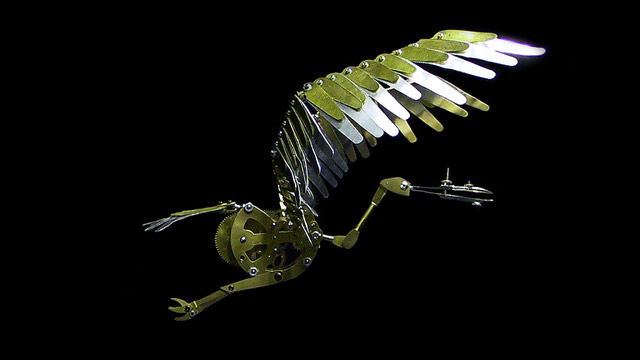With a background in puppet animation and a thriving commercial practice as an architect, Dik Jarman celebrated the life of his late father in a very special autobiographical account of a complex relationship. Fearing at first that animating the story might be too clichéd, Dik was persuaded by friends and family that it would be both a worthwhile memorial and animation project. How right they were. Dad’s Clock records, in a multi-faceted series of metaphors, the passion of one man in the receding days of his life.
It commences with a giant stork-like, metal bird, beautifully crafted—there can be no other word for all the prop and puppet design here—sweeping down over a wooden carcass of a ship, the struts and frame boat and the skeletal system of a giant animal. The ship is floating on strips of wood, like complex pedals of a vast cathedral organ, the gently undulating lathes forming the sea. We become aware of a bespectacled figure immersed in the innards, studiously working on the cogs and wheels of his wooden clock. When the bell rings it is with the resonance of the giant metal bowls in the heights of Notre Dame. There is no Quasimodo figure however, just an old man hard at work, the passage of time and the disease revealed in his transparent, emaciating figure. The soundtrack is the bells and ticking of the clock.
Visually, this stop-motion movie is stunning even in the reduced quality available. Building the set and puppets took one year alone. The studio set is remarkable—artfully lit, providing ample scope for the camera to pan around. We see the clock-maker from different angles—his face sculptured from wood cast in the warm glow from his lantern; or we look down from above and marvel at the symmetry of the boat beneath.
Veteran actor Barry Otto narrates the story of Dik’s relationship with his father with such sincerity I believed, until I read the credits, that it was the director himself speaking. It is a complex work involving guilt over the death of his younger brother, John, who died at the age of five, 14 years before Dik was born. The consequent sadness in the family was one from which Dik felt excluded. Unlike the sudden death of a road accident the slowness of cancer allowed the son to say goodbye and “hello”. When his father dies his ashes are buried with those of his long dead son. In a moving passage of commentary the difference in quantity of the ashes between the two, boy and man, achieves both reconciliation and a release.
Dik was courteous in replying to questions from one of my students, Adam Fadra, in an extended interview for my school website last year and provides ample detail about the production. For example, the “hero bird” was assembled from brass, aluminium and bits of one of his father’s clocks whilst the process involved Dik constructing a thousand moving parts and making 22,000 images.
I see a lot of animated movies. Dad’s Clock stands out for a number of reasons, its candour being one. I have never seen a set of this complexity, a work of art in itself. The supreme craftsmanship allows Dik to form striking tableaux: the skeleton figure peering into his telescope out to the stars on top of the symmetrical alignment of timber, figure and ship viewed in front of the backdrop of the cosmos. When the old man descends for a final time into the machine and the mechanism closes around him it is an obvious metaphor but an effective one.
Dik’s personal and dignified tribute deserves greater recognition than it has received other than the director’s Australian home. His design and architecture company Studio 505 is situated in Melbourne.
